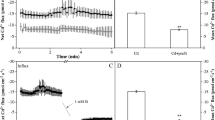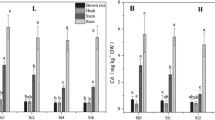Abstract
Purpose
Silicon (Si) has inhibitory effects on cadmium (Cd) toxicity in rice, but the effects of Si-containing materials on the chemical properties of hydroponic media have been ignored. The increased pH value and introduction of excess cations when utilizing alkaline reagents may disguise the true function of the Si. Thus, the present study investigated Si-alleviated effect on Cd toxicity in rice seedlings by eliminating the aforementioned interferences.
Materials and methods
The hydroponic cultivation of rice seedlings was carried out to demonstrate the inhibiting effects of exogenous Si on Cd accumulation and distribution. The chlorophyll and carotenoid contents in leaf cells under Cd stress were also measured. Transmission electron microscopy was used to investigate ultrastructural changes in rice mesophyll cells, chloroplasts, and mitochondria under different Cd-stressed and Si-amended conditions. The alkalinity of the Si source was neutralized with nitric acid, and discrepancies in Na+ levels was eliminated by the addition of sodium nitrate to different treatments.
Results and discussion
Toxicity symptoms were observed in rice seedlings under Cd (5 mg L−1) treatment after 35 days, and the biomass, and chlorophyll and carotenoid contents, were lowered. The levels of these indices increased after adding 120 mg L−1 Si. The bioconcentration and translocation factor values indicated that Si reduced Cd accumulation in rice plants and also decreased the ratio of Cd translocation from roots to shoots, which effectively alleviated the Cd toxicity. The positive effects of Si were mainly reflected in the recovery of grana lamellae and membrane structures in chloroplasts, and restored membrane morphology and increased numbers of cristae in mitochondria.
Conclusions
Exogenous Si reduced Cd uptake in rice seedlings, especially in shoots, and inhibited Cd transport into aboveground parts. In addition, Si restored the functions of chloroplasts owing to a decrease in lipid peroxidation. The application of Si indicated that Cd toxicity is alleviated partly because of the improvement in chloroplast biosynthesis and the diminution of Cd bioavailability.





Similar content being viewed by others
References
Adrees M, Ali S, Rizwan M, Zia-ur-Rehman M, Ibrahim M, Abbas F, Farid M, Qayyum MF, Irshad MK (2015) Mechanisms of silicon-mediated alleviation of heavy metal toxicity in plants. A review. Ecotoxicol Environ Saf 119:186–197. https://doi.org/10.1016/j.ecoenv.2015.05.011
Ahammed GJ, Choudhary SP, Chen S, Xia X, Shi K, Zhou Y, Yu J (2013) Role of brassinosteroids in alleviation of phenanthrene-cadmium co-contamination-induced photosynthetic inhibition and oxidative stress in tomato. J Exp Bot 64(1):199–213. https://doi.org/10.1093/jxb/ers323
ATSDR (Agency for Toxic Substances and Disease Registry) (1999) Toxicological profile for lead. U.S. Department of Health and Human Services, Public Health Service, Atlanta
Baruah S, Bora MS, Sharma P, Deb P, Sarma KP (2017) Understanding of the distribution, translocation, bioaccumulation, and ultrastructural changes of Monochoria hastata plant exposed to cadmium. Water Air Soil Pollut 228(1):17. https://doi.org/10.1007/s11270-016-3092-8
Bhaduri AM, Fulekar MH (2012) Antioxidant enzyme responses of plants to heavy metal stress. Rev Environ Sci Biotechnol 11(1):55–69. https://doi.org/10.1007/s11157-011-9251-x
Boffetta P (1993) Carcinogenicity of trace elements with reference to evaluations made by the International Agency for Research on Cancer. Scand J Work Environ Health 19(Suppl 1):67–70
Cooke J, Leishman MR (2016) Alleviation of abiotic stress by silicon what can a meta-analysis of agricultural studies tell us about ecology? British Ecological Society Annual Meeting 2016, Liverpool, UK
Cui JH, Liu TX, Li FB, Yi JC, Liu CP, HY Y (2017) Silica nanoparticles alleviate cadmium toxicity in rice cells: mechanisms and size effects. Environ Pollut 228:363–369. https://doi.org/10.1016/j.envpol.2017.05.014
Da Cunha KPV, Do Nascimento CWA (2009) Silicon effects on metal tolerance and structural changes in maize (Zea mays L.) grown on a cadmium and zinc enriched soil. Water Air Soil Pollut 197:323–330
Dar MI, Green ID, Naikoo MI, Khan FA, Ansari AA, Lone MI (2017) Assessment of biotransfer and bioaccumulation of cadmium, lead and zinc from fly ash amended soil in mustard-aphid-beetle food chain. Sci Total Environ 584–585:1221–1229
Daud MK, Mei L, Azizullah A, Dawood M, Ali I, Mahmood Q, Ullah W, Jamil M, Zhu SJ (2016) Leaf-based physiological, metabolic, and ultrastructural changes in cultivated cotton cultivars under cadmium stress mediated by glutathione. Environ Sci Pollut Res 23(15):15551–15564. https://doi.org/10.1007/s11356-016-6739-5
Doncheva S, Poschenrieder C, Stoyanova Z, Georgieva K, Velichkova M, Barceló J (2009) Silicon amelioration of manganese toxicity in Mn-sensitive and Mn-tolerant maize varieties. Environ Exp Bot 65(2-3):189–197. https://doi.org/10.1016/j.envexpbot.2008.11.006
EPD (Environmental Protection Department of the People’s Republic of China) (2014) The Ministry of Land and Resources of People’s Republic of China. The soil pollution condition investigation communique. Beijing
Ezedom T, Asagba SO (2016) Effect of a controlled food-chain mediated exposure to cadmium and arsenic on oxidative enzymes in the tissues of rats. Toxicol Rep 3:708–715. https://doi.org/10.1016/j.toxrep.2016.07.002
Farooq MA, Ali S, Hameed A, Ishaque W, Mahmood K, Iqbal Z (2013) Alleviation of cadmium toxicity by silicon is related to elevated photosynthesis, antioxidant enzymes; suppressed cadmium uptake and oxidative stress in cotton. Ecotoxicol Environ Saf 96:242–249. https://doi.org/10.1016/j.ecoenv.2013.07.006
Gzyl J, Przymusiński R, Gwóźdź EA (2009) Ultrastructure analysis of cadmium-tolerant and -sensitive cell lines of cucumber (Cucumis sativus L.) Plant Cell Tissue Organ Cult (PCTOC) 99(2):227–232. https://doi.org/10.1007/s11240-009-9583-1
Hasan SA, Hayat S, Ahmad A (2011) Brassinosteroids protect photosynthetic machinery against the cadmium induced oxidative stress in two tomato cultivars. Chemosphere 84(10):1446–1451. https://doi.org/10.1016/j.chemosphere.2011.04.047
Hossain MT, Mori R, Soga K, Wakabayashi K, Kamisaka S, Fujii S, Yamamoto R, Hoson T (2002) Growth promotion and an increase in cell wall extensibility by silicon in rice and some other Poaceae seedlings. J Plant Res 115(1):23–27. https://doi.org/10.1007/s102650200004
Hu YL, Ge Y, Zhang CH, Ju T, Cheng WD (2009) Cadmium toxicity and translocation in rice seedlings are reduced by hydrogen peroxide pretreatment. Plant Growth Regul 59:51
Khan MU, Malik RN, Muhammad S (2013) Human health risk from heavy metal via food crops consumption with wastewater irrigation practices in Pakistan. Chemosphere 93(10):2230–2238. https://doi.org/10.1016/j.chemosphere.2013.07.067
Kuhlmann AM (1963) The second most abundant element in the Earth’s crust. Jom-Us 15(7):502–505. https://doi.org/10.1007/BF03378936
Li M, Wang GR, Li JY, Cao FB (2016) Foliar application of betaine alleviates cadmium toxicity in maize seedlings. Acta Physiol Plant 38(4):95. https://doi.org/10.1007/s11738-016-2116-8
Liang YC, Yang CG, Shi HH (2001) Effects of silicon on growth and mineral composition of barley grown under toxic levels of aluminum. J Plant Nutr 24(2):229–243. https://doi.org/10.1081/PLN-100001384
Liu CP, Li FB, Luo CL, Liu XM, Wang SH, Liu TX, Li XD (2009) Foliar application of two silica sols reduced cadmium accumulation in rice grains. J Hazard Mater 16:1466–1472
Liu J, Ma J, He CW, Li XL, Zhang WJ, FS X, Lin YJ, Wang LJ (2013) Inhibition of cadmium ion uptake in rice (Oryza sativa) cells by a wall-bound form of silicon. New Phytol 200(3):691–699. https://doi.org/10.1111/nph.12494
López-Millán A, Sagardoy R, Solanas M, Abadía A, Abadía J (2009) Cadmium toxicity in tomato (Lycopersicon esculentum) plants grown in hydroponics. Environ Exp Bot 65(2-3):376–385. https://doi.org/10.1016/j.envexpbot.2008.11.010
Lukačová Z, Švubová R, Kohanová J, Lux A (2013) Silicon mitigates the Cd toxicity in maize in relation to cadmium translocation, cell distribution, antioxidant enzymes stimulation and enhanced endodermal apoplasmic barrier development. Plant Growth Regul 70(1):89–103. https://doi.org/10.1007/s10725-012-9781-4
Malec P, Maleva MG, Prasad MNV, Strzałka K (2010) Responses of Lemna trisulca L. (Duckweed) exposed to low doses of cadmium thiols, metal binding complexes, and photosynthetic pigments as sensitive biomarkers of ecotoxicity. Protoplasma 240(1-4):69–74. https://doi.org/10.1007/s00709-009-0091-2
Mbonankira JE, Coq S, Vromman D, Lutts S, Nizigiyimana A, Bertin P (2015) Catalase and ascorbate peroxidase activities are not directly involved in the silicon-mediated alleviation of ferrous iron toxicity in rice. J Plant Nutr Soil Sci 178(3):477–485. https://doi.org/10.1002/jpln.201400068
Nwugo CC, Huerta AJ (2008a) Effects of silicon nutrition on cadmium uptake, growth and photosynthesis of rice plants exposed to low-level cadmium. Plant Soil 311(1-2):73–86. https://doi.org/10.1007/s11104-008-9659-4
Nwugo CC, Huerta AJ (2008b) Silicon-induced cadmium resistance in rice (Oryza sativa). J Plant Nutr Soil Sci 171(6):841–848. https://doi.org/10.1002/jpln.200800082
Petoumenou MI, Pizzo F, Cester J, Fernández A, Benfenati E (2015) Comparison between bioconcentration factor (BCF) data provided by industry to the European Chemicals Agency (ECHA) and data derived from QSAR models. Environ Res 142:529–534. https://doi.org/10.1016/j.envres.2015.08.008
Piper D, Caicedo RJF (2013) Lead and cadmium priorities for action from UNEP’s perspective for addressing risks posed by these two heavy metals. E3S Web of Conferences 30004:1–4
Rahman A, Nahar K, Hasanuzzaman M, Fujita M (2016) Manganese-induced cadmium stress tolerance in rice seedlings coordinated action of antioxidant defense, glyoxalase system and nutrient homeostasis. C R Biol 339(11-12):462–474. https://doi.org/10.1016/j.crvi.2016.08.002
Rizwan M, Meunier JD, Miche H, Keller C (2012) Effect of silicon on reducing cadmium toxicity in durum wheat (Triticum turgidum L. cv. Claudio W.) grown in a soil with aged contamination. J Hazard Mater 209:326–334
Rizwan M, Meunier JD, Davidian JC, Pokrovsky OS, Bovet N, Keller C (2016) Silicon alleviates Cd stress of wheat seedlings (Triticum turgidum L. cv. Claudio) grown in hydroponics. Environ Sci Pollut Res 23(2):1414–1427. https://doi.org/10.1007/s11356-015-5351-4
Shi GR, Cai QS, Liu CF, Wu L (2010) Silicon alleviates cadmium toxicity in peanut plants in relation to cadmium distribution and stimulation of antioxidative enzymes. Plant Growth Regul 61(1):45–52. https://doi.org/10.1007/s10725-010-9447-z
Srivastava RK, Pandey P, Rajpoot R, Rani A, Gautam A, Dubey RS (2015) Exogenous application of calcium and silica alleviates cadmium toxicity by suppressing oxidative damage in rice seedlings. Protoplasma 252(4):959–975. https://doi.org/10.1007/s00709-014-0731-z
Tian SK, LL L, Zhang J, Wang K, Brown P, He ZL, Liang J, Yang XE (2011) Calcium protects roots of Sedum alfredii H. against cadmium-induced oxidative stress. Chemosphere 84(1):63–69. https://doi.org/10.1016/j.chemosphere.2011.02.054
Tripathi DK, Singh VP, Kumar D, Chauhan DK (2012) Rice seedlings under cadmium stress effect of silicon on growth, cadmium uptake, oxidative stress, antioxidant capacity and root and leaf structures. Chem Ecol 28(3):281–291. https://doi.org/10.1080/02757540.2011.644789
Upadhyay RK, Panda SK (2009) Copper-induced growth inhibition, oxidative stress and ultrastructural alterations in freshly grown water lettuce (Pistia stratiotes L). C R Biol 332(7):623–632. https://doi.org/10.1016/j.crvi.2009.03.001
Vaculík M, Pavlovič A, Lux A (2015) Silicon alleviates cadmium toxicity by enhanced photosynthetic rate and modified bundle sheath’s cell chloroplasts ultrastructure in maize. Ecotoxicol Environ Saf 120:66–73. https://doi.org/10.1016/j.ecoenv.2015.05.026
Wang F, Chen F, Cai Y, Zhang GP, Wu FB (2011) Modulation of exogenous glutathione in ultrastructure and photosynthetic performance against Cd stress in the two barley genotypes differing in Cd tolerance. Biol Trace Elem Res 144(1-3):1275–1288. https://doi.org/10.1007/s12011-011-9121-y
Wellburn AR (1994) The spectral determination of chlorophylls a and b, as well as total carotenoids, using various solvents with spectrophotometers of different resolution. J Plant Physiol 144(3):307–313. https://doi.org/10.1016/S0176-1617(11)81192-2
Wu M, Wang PY, Sun LG, Zhang JJ, Yu J, Wang YW, Chen GX (2014) Alleviation of cadmium toxicity by cerium in rice seedlings is related to improved photosynthesis, elevated antioxidant enzymes and decreased oxidative stress. Plant Growth Regul 74(3):251–260
Wu JW, Geilfus CM, Pitann B, Mühling KH (2016) Silicon-enhanced oxalate exudation contributes to alleviation of cadmium toxicity in wheat. Environ Exp Bot 131:10–18
Xie Y, Luo HJ, LX H, Sun XY, Lou YH, Fu JM (2014) Classification of genetic variation for cadmium tolerance in Bermudagrass [Cynodon dactylon (L.) Pers.] using physiological traits and molecular markers. Ecotoxicology 23(6):1030–1043. https://doi.org/10.1007/s10646-014-1247-1
Zeng FR, Zhao FS, Qiu BY, OuYang YN, Wu FB, Zhang GP (2011) Alleviation of chromium toxicity by silicon addition in rice plants. Agric Sci China 10(8):1188–1196. https://doi.org/10.1016/S1671-2927(11)60109-0
Zhang CC, Wang LJ, Nie Q, Zhang WX, Zhang FS (2008) Long-term effects of exogenous silicon on cadmium translocation and toxicity in rice (Oryza sativa L). Environ Exp Bot 62(3):300–307. https://doi.org/10.1016/j.envexpbot.2007.10.024
Acknowledgments
We thank Lesley Benyon, PhD, for editing the English text of a draft of this manuscript.
Funding
This project was financially supported by the National Natural Science Foundation of China (Grant No. 41371306), and the “123” Project of the China Environment Protect Foundation (Grant No. CEPF2013-123-1-5).
Author information
Authors and Affiliations
Corresponding author
Additional information
Responsible editor: Claudio Bini
Rights and permissions
About this article
Cite this article
Guo, L., Chen, A., He, N. et al. Exogenous silicon alleviates cadmium toxicity in rice seedlings in relation to Cd distribution and ultrastructure changes. J Soils Sediments 18, 1691–1700 (2018). https://doi.org/10.1007/s11368-017-1902-2
Received:
Accepted:
Published:
Issue Date:
DOI: https://doi.org/10.1007/s11368-017-1902-2




